UGC NET Exam > UGC NET Questions > A conducting wire in the shape of a circle li...
Start Learning for Free
A conducting wire in the shape of a circle lies on the (x, y) -plane, with its centre at the origin. A bar magnet moves with a constant velocity towards the wire along the z-axis (as shown in the figure below).

We take t = 0 to be the instant at which the midpoint of the magnet is at the centre of the wire loop and the induced current to be positive when it is counter-clockwise as viewed by the observer facing the loop and the incoming magnet. In these conventions, the best schematic representation of the induced current I(t) as a function of t, is

We take t = 0 to be the instant at which the midpoint of the magnet is at the centre of the wire loop and the induced current to be positive when it is counter-clockwise as viewed by the observer facing the loop and the incoming magnet. In these conventions, the best schematic representation of the induced current I(t) as a function of t, is
- a)
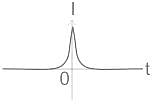
- b)
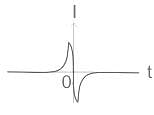
- c)
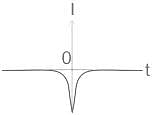
- d)
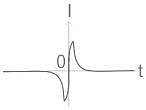
Correct answer is option 'D'. Can you explain this answer?
| FREE This question is part of | Download PDF Attempt this Test |
Most Upvoted Answer
A conducting wire in the shape of a circle lies on the (x, y) -plane, ...
CONCEPT:
Lenz law- Lenz law defines the direction of the current induced by changing the magnetic field such that it opposes the change in the flux and the direction of the flow of the current is taken by Fleming's right-hand rule.
EXPLANATION:
When t < 0, the magnetic flux will increase and emf is generated, according to Lenz's law to decrease the effect of the magnetic flux, the current is taken in a clockwise direction and the magnetic field is downwards. Therefore, when we see from the positive z-direction the current is in the clockwise direction, the current will decrease with respect to the time t < 0.
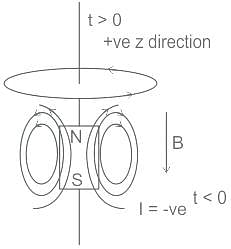
When t > 0, the magnetic flux will decrease and the magnetic field in in the upward direction when we see the current from the upward direction, it is in the anticlockwise direction which means that it is positive.
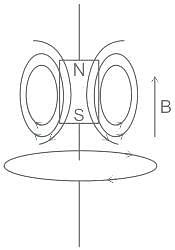

When t > 0, the magnetic flux will decrease and the magnetic field in in the upward direction when we see the current from the upward direction, it is in the anticlockwise direction which means that it is positive.

Attention UGC NET Students!
To make sure you are not studying endlessly, EduRev has designed UGC NET study material, with Structured Courses, Videos, & Test Series. Plus get personalized analysis, doubt solving and improvement plans to achieve a great score in UGC NET.

|
Explore Courses for UGC NET exam
|

|
Similar UGC NET Doubts
A conducting wire in the shape of a circle lies on the (x, y) -plane, with its centre at the origin. A bar magnet moves with a constant velocity towards the wire along the z-axis (as shown in the figure below).We take t = 0 to be the instant at which the midpoint of the magnet is at the centre of the wire loop and the induced current to be positive when it is counter-clockwise as viewed by the observer facing the loop and the incoming magnet. In these conventions, the best schematic representation of the induced current I(t) as a function of t, isa)b)c)d)Correct answer is option 'D'. Can you explain this answer?
Question Description
A conducting wire in the shape of a circle lies on the (x, y) -plane, with its centre at the origin. A bar magnet moves with a constant velocity towards the wire along the z-axis (as shown in the figure below).We take t = 0 to be the instant at which the midpoint of the magnet is at the centre of the wire loop and the induced current to be positive when it is counter-clockwise as viewed by the observer facing the loop and the incoming magnet. In these conventions, the best schematic representation of the induced current I(t) as a function of t, isa)b)c)d)Correct answer is option 'D'. Can you explain this answer? for UGC NET 2025 is part of UGC NET preparation. The Question and answers have been prepared according to the UGC NET exam syllabus. Information about A conducting wire in the shape of a circle lies on the (x, y) -plane, with its centre at the origin. A bar magnet moves with a constant velocity towards the wire along the z-axis (as shown in the figure below).We take t = 0 to be the instant at which the midpoint of the magnet is at the centre of the wire loop and the induced current to be positive when it is counter-clockwise as viewed by the observer facing the loop and the incoming magnet. In these conventions, the best schematic representation of the induced current I(t) as a function of t, isa)b)c)d)Correct answer is option 'D'. Can you explain this answer? covers all topics & solutions for UGC NET 2025 Exam. Find important definitions, questions, meanings, examples, exercises and tests below for A conducting wire in the shape of a circle lies on the (x, y) -plane, with its centre at the origin. A bar magnet moves with a constant velocity towards the wire along the z-axis (as shown in the figure below).We take t = 0 to be the instant at which the midpoint of the magnet is at the centre of the wire loop and the induced current to be positive when it is counter-clockwise as viewed by the observer facing the loop and the incoming magnet. In these conventions, the best schematic representation of the induced current I(t) as a function of t, isa)b)c)d)Correct answer is option 'D'. Can you explain this answer?.
A conducting wire in the shape of a circle lies on the (x, y) -plane, with its centre at the origin. A bar magnet moves with a constant velocity towards the wire along the z-axis (as shown in the figure below).We take t = 0 to be the instant at which the midpoint of the magnet is at the centre of the wire loop and the induced current to be positive when it is counter-clockwise as viewed by the observer facing the loop and the incoming magnet. In these conventions, the best schematic representation of the induced current I(t) as a function of t, isa)b)c)d)Correct answer is option 'D'. Can you explain this answer? for UGC NET 2025 is part of UGC NET preparation. The Question and answers have been prepared according to the UGC NET exam syllabus. Information about A conducting wire in the shape of a circle lies on the (x, y) -plane, with its centre at the origin. A bar magnet moves with a constant velocity towards the wire along the z-axis (as shown in the figure below).We take t = 0 to be the instant at which the midpoint of the magnet is at the centre of the wire loop and the induced current to be positive when it is counter-clockwise as viewed by the observer facing the loop and the incoming magnet. In these conventions, the best schematic representation of the induced current I(t) as a function of t, isa)b)c)d)Correct answer is option 'D'. Can you explain this answer? covers all topics & solutions for UGC NET 2025 Exam. Find important definitions, questions, meanings, examples, exercises and tests below for A conducting wire in the shape of a circle lies on the (x, y) -plane, with its centre at the origin. A bar magnet moves with a constant velocity towards the wire along the z-axis (as shown in the figure below).We take t = 0 to be the instant at which the midpoint of the magnet is at the centre of the wire loop and the induced current to be positive when it is counter-clockwise as viewed by the observer facing the loop and the incoming magnet. In these conventions, the best schematic representation of the induced current I(t) as a function of t, isa)b)c)d)Correct answer is option 'D'. Can you explain this answer?.
Solutions for A conducting wire in the shape of a circle lies on the (x, y) -plane, with its centre at the origin. A bar magnet moves with a constant velocity towards the wire along the z-axis (as shown in the figure below).We take t = 0 to be the instant at which the midpoint of the magnet is at the centre of the wire loop and the induced current to be positive when it is counter-clockwise as viewed by the observer facing the loop and the incoming magnet. In these conventions, the best schematic representation of the induced current I(t) as a function of t, isa)b)c)d)Correct answer is option 'D'. Can you explain this answer? in English & in Hindi are available as part of our courses for UGC NET.
Download more important topics, notes, lectures and mock test series for UGC NET Exam by signing up for free.
Here you can find the meaning of A conducting wire in the shape of a circle lies on the (x, y) -plane, with its centre at the origin. A bar magnet moves with a constant velocity towards the wire along the z-axis (as shown in the figure below).We take t = 0 to be the instant at which the midpoint of the magnet is at the centre of the wire loop and the induced current to be positive when it is counter-clockwise as viewed by the observer facing the loop and the incoming magnet. In these conventions, the best schematic representation of the induced current I(t) as a function of t, isa)b)c)d)Correct answer is option 'D'. Can you explain this answer? defined & explained in the simplest way possible. Besides giving the explanation of
A conducting wire in the shape of a circle lies on the (x, y) -plane, with its centre at the origin. A bar magnet moves with a constant velocity towards the wire along the z-axis (as shown in the figure below).We take t = 0 to be the instant at which the midpoint of the magnet is at the centre of the wire loop and the induced current to be positive when it is counter-clockwise as viewed by the observer facing the loop and the incoming magnet. In these conventions, the best schematic representation of the induced current I(t) as a function of t, isa)b)c)d)Correct answer is option 'D'. Can you explain this answer?, a detailed solution for A conducting wire in the shape of a circle lies on the (x, y) -plane, with its centre at the origin. A bar magnet moves with a constant velocity towards the wire along the z-axis (as shown in the figure below).We take t = 0 to be the instant at which the midpoint of the magnet is at the centre of the wire loop and the induced current to be positive when it is counter-clockwise as viewed by the observer facing the loop and the incoming magnet. In these conventions, the best schematic representation of the induced current I(t) as a function of t, isa)b)c)d)Correct answer is option 'D'. Can you explain this answer? has been provided alongside types of A conducting wire in the shape of a circle lies on the (x, y) -plane, with its centre at the origin. A bar magnet moves with a constant velocity towards the wire along the z-axis (as shown in the figure below).We take t = 0 to be the instant at which the midpoint of the magnet is at the centre of the wire loop and the induced current to be positive when it is counter-clockwise as viewed by the observer facing the loop and the incoming magnet. In these conventions, the best schematic representation of the induced current I(t) as a function of t, isa)b)c)d)Correct answer is option 'D'. Can you explain this answer? theory, EduRev gives you an
ample number of questions to practice A conducting wire in the shape of a circle lies on the (x, y) -plane, with its centre at the origin. A bar magnet moves with a constant velocity towards the wire along the z-axis (as shown in the figure below).We take t = 0 to be the instant at which the midpoint of the magnet is at the centre of the wire loop and the induced current to be positive when it is counter-clockwise as viewed by the observer facing the loop and the incoming magnet. In these conventions, the best schematic representation of the induced current I(t) as a function of t, isa)b)c)d)Correct answer is option 'D'. Can you explain this answer? tests, examples and also practice UGC NET tests.

|
Explore Courses for UGC NET exam
|

|
Suggested Free Tests
Signup for Free!
Signup to see your scores go up within 7 days! Learn & Practice with 1000+ FREE Notes, Videos & Tests.
























